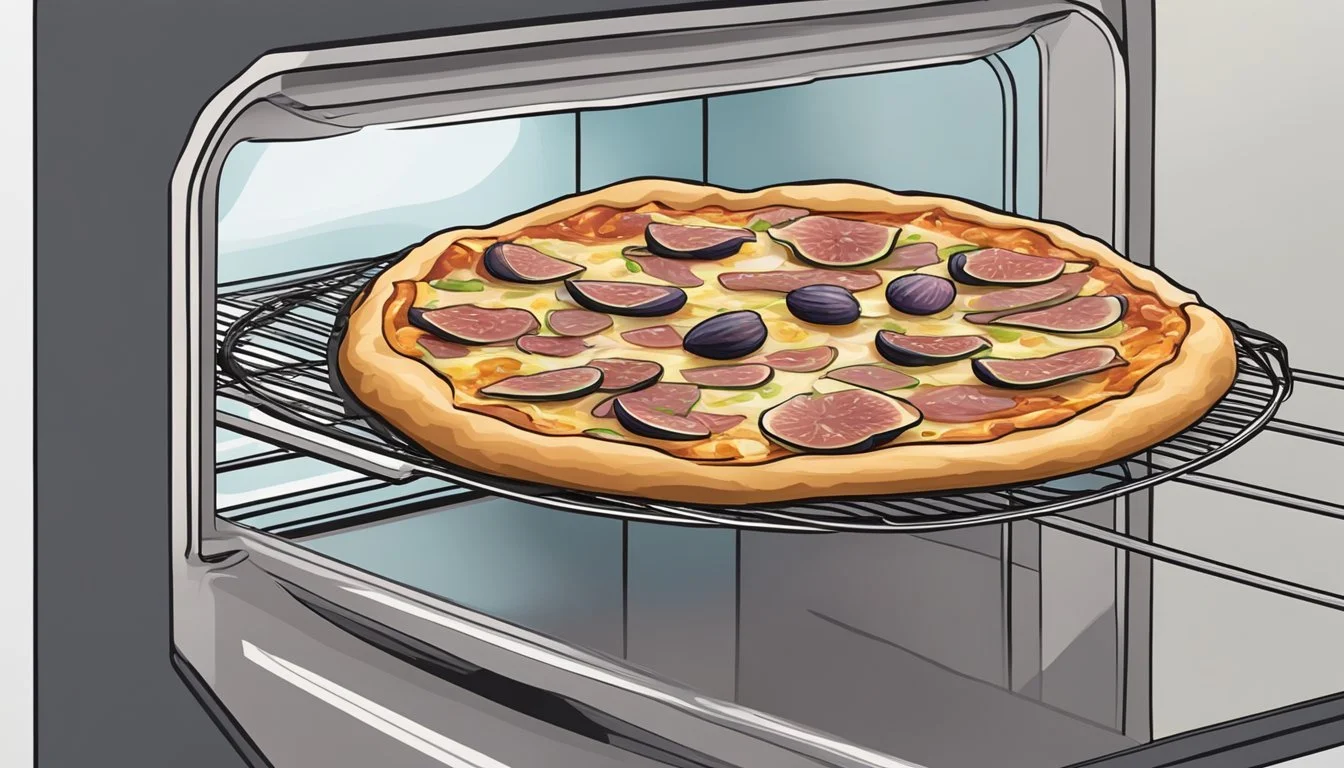Best Way to Reheat Fig and Prosciutto Pizza
Ensuring a Crispy Crust Every Time
Reheating pizza, particularly a gourmet slice like fig and prosciutto pizza, is an art that pizza aficionados have perfected over time. Unlike fresh pizza, leftover slices have lost some of their original moisture and crispness, making it crucial to employ the best method to both preserve the delicate flavors of fig and prosciutto and restore the crust's satisfying crunch. The goal is to achieve a balance that mimics the pizza's just-out-of-the-oven quality without drying it out or rendering the crust soggy.
Experts on pizza preparation agree that the oven method stands out as the most effective way to reheat pizza while keeping its crust crispy. Directly placing the slices on an oven rack, sometimes with the support of foil, and heating them at a temperature around 350°F ensures that the heat is distributed evenly. This technique allows the cheese to melt perfectly without causing the crust to become too hard or chewy. For those with a gourmet palate, this method also helps in retaining the nuanced flavors of toppings like fig and prosciutto, which delicate flavors can be lost when reheated improperly.
Although the oven is highly recommended, alternative methods exist for those seeking a quicker fix or lacking an oven. In such cases, a skillet on medium heat can also yield a crispy crust and warm toppings, all while keeping the slice's integrity intact. Understanding the intricacies of each reheating technique can therefore ensure that the leftover pizza experience rivals that of enjoying a fresh slice straight from the pizza kitchen.
Overview of Reheating Methods
Reheating fig and prosciutto pizza properly is crucial to maintain its delectable balance of sweet, savory, and crispy textures. Below are various reheating methods to revitalize your pizza while keeping its crust crispy.
Microwave Method
In a microwave, a short burst at 30-40 percent power for around 45 seconds can warm the pizza. To avoid a chewy crust, placing a cup of water in the microwave during reheating may introduce steam that minimizes toughness.
Oven Method
Preheat your oven to 350°F (175°C). Use a baking sheet or aluminum foil, and place the pizza on the center rack. Heat for about 10 minutes for a crispy crust. Starting in a cold oven and then setting it to heat can also gradually reheat the pizza evenly without burning the crust.
Stovetop Method
Place the pizza in a skillet on medium heat for a few minutes until the bottom becomes crunchy. Using a cast iron or nonstick pan helps in achieving a crispy crust.
Air Fryer Method
Set the air fryer to 325-350°F (about 163-177°C) and place the slices in the basket. The circulating air ensures a crispy finish in just a few minutes, typically around 3-4 minutes for the crust to crisp up.
Toaster Oven Method
For a toaster oven, arrange the pizza on the lowest rack to ensure a crispy crust. Bake at a similar temperature to a standard oven (350°F), but for a shorter duration, usually around 4 to 5 minutes.
Grill Method
A grill can reheat pizza and add a unique smoky flavor. Set the grill to a medium-high temperature, place the pizza on aluminum foil, and check frequently until the desired crispiness is achieved, usually in about 5-6 minutes.
Preparing Pizza for Reheating
Proper preparation is crucial for reheating fig and prosciutto pizza to ensure it retains its original flavor and texture. This involves correct storage beforehand and appropriate handling during the reheating process.
Handling Frozen Pizza
When one has leftovers that are frozen, the pizza should be thawed in the fridge for several hours prior to reheating. This gradual thawing is important as it maintains the pizza's texture, preventing the crust from becoming soggy. It's best to avoid thawing fig and prosciutto pizza at room temperature, which might lead to bacterial growth.
Container and Wrapping
To store leftover pizza in the fridge, place it in an airtight container or wrap it tightly with plastic wrap or foil. For those opting to use resealable plastic bags, ensure that as much air as possible is removed before sealing. This prevents moisture from forming and keeps the crust from becoming chewy. When ready to reheat, remove the pizza from the fridge and let it sit at room temperature for a few minutes, then unwrap it and, if possible, place it on parchment paper which assists in keeping the crust dry during reheating.
Preserving Quality and Taste
When reheating a fig and prosciutto pizza, the primary goals are to maintain the pizza's freshness and taste while ensuring the crust stays crispy. It is crucial to manage moisture properly and accurately adjust both temperature and cooking time.
Managing Moisture and Toppings
Excess moisture is the enemy of a crispy crust. To counteract this, one should place paper towels under and over the pizza when microwaving to absorb steam. Toppings like fig and prosciutto, which may release moisture, should be monitored and, if necessary, patted dry before reheating. When reheating in an oven, avoid covering the pizza as this creates steam and can result in a soggy crust.
Before reheating: Pat toppings dry with a paper towel if they appear moist.
Microwave reheating: Place the slice on a paper towel and cover it with another paper towel to absorb moisture.
Adjusting Temperature and Time
For a crispy crust, a hot oven is key. Preheating the oven to around 350°F (175°C) is optimal. Place the pizza directly on the middle rack for even heat circulation, which, for a standard oven, usually takes about 10 minutes. A toaster oven can be used for smaller slices, similarly preheated, but adjusting the time due to its quicker heating elements. Always keep an eye on the cheese, as it needs to be gooey and melty, without burning.
Oven reheating:
Preheat to 350°F (175°C).
Heating time: approximately 10 minutes.
Check the pizza halfway to ensure the cheese and toppings are heated evenly.
Safety and Storage Tips
When storing fig and prosciutto pizza, one's primary concern should be maintaining its quality and safety. Pizza generally should not sit out at room temperature for more than two hours, as bacteria can grow rapidly between 40°F and 140°F, a range known as the danger zone.
Refrigeration: Leftovers should be placed in the fridge within this two-hour window. To ensure the pizza retains its moisture and flavor, wrapping the pizza in plastic wrap or placing it in an airtight container is recommended.
Plastic Wrap: Wrap slices individually to maintain freshness.
Airtight Container: If available, use a container that limits air exposure.
Shelf Life: Properly stored, the pizza can last in the fridge for 3-4 days. Here’s a trick to prevent soggy crusts — place a paper towel beneath the pizza to absorb excess moisture that may cause the crust to soften. It is critical to keep the pizza way from raw foods in the fridge to prevent cross-contamination.
Freezing: In case you want to extend the life of your pizza beyond a few days, consider freezing it. Here are the steps for freezing:
Cool Down: Ensure pizza has fully cooled to avoid condensation and ice crystals.
Preparation: Wrap pizza slices in plastic, then in aluminum foil, or place them in a freezer-safe airtight container.
Thawing: When ready to eat, thaw in the fridge before reheating to ensure even warming.
Note: Always inspect the pizza before reheating. If there's any sign of spoilage—odd smell, discolored toppings—discard it to avoid foodbourne illnesses. Following these tips can help preserve your fig and prosciutto pizza and ensure it remains safe to eat.
Final Thoughts on Pizza Reheating Techniques
Reheating fig and prosciutto pizza presents a unique challenge due to the delicate flavors and the desire for a crispy crust. Pizza connoisseurs agree that the right technique can resurrect a slice to nearly its original glory.
For a balance between crispiness and a gooey cheese topping, they suggest a two-step oven method:
Preheat the oven to 350°F with a baking sheet inside.
Once preheated, transfer the pizza to the hot sheet.
This achieves an evenly heated slice with a crisp bottom in about ten minutes. A skillet can also be effective for smaller quantities; just ensure a tight-fitting lid to trap heat and moisture.
When handling delivery pizza, especially one with delicate toppings like fig and prosciutto, always monitor the reheating process to prevent overcooking. Pizza enthusiasts emphasize the importance of those few extra minutes, which can make the difference between a soggy crust and the desired crispy texture.
There's no one-size-fits-all approach to reheating pizza; it should be tailored to the slice in question. For instance, those with a thicker crust may require a longer time, while a thin crust demands a watchful eye to prevent charring. By using these techniques, even a day-old slice can provide a delicious, oven-fresh experience.



